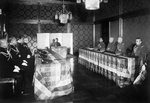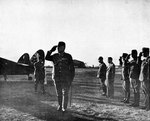Hajime Sugiyama
| Surname | Sugiyama |
| Given Name | Hajime |
| Born | 1880 |
| Died | 12 Sep 1945 |
| Country | Japan |
| Category | Military-Ground |
| Gender | Male |
Contributor: C. Peter Chen
ww2dbaseHajime Sugiyama was born in Kokura, Fukuoka Prefecture, Japan into a samurai family. He served as a lieutenant in the infantry in the Russo-Japanese War, then attended the Imperial Japanese Army Academy, graduating in 1910. In 1912, he was sent to the Philippines and Singapore as a military attaché. He was promoted to the rank of major in 1913 and transferred to India. He returned to Japan in 1918 and was promoted lieutenant colonel. In Dec 1918, he was named commanding officer of the 2nd Air Battalion for his exposure to German aircraft in the 1910s. He was promoted to the rank of colonel in 1921, and in the following year became the first head of the Imperial Japanese Army Air Service. In May 1925, he was promoted major general. In Jun 1930, he was made the acting Vice War Minister, and two months later officially took over that position, coupled with a promotion to the rank of lieutenant general. In Mar 1933, he took on a second role as the commander of the Imperial Japanese Army Air Service. In Mar 1936, after the Feb 26 Incident, he became the War Minister. He became a full general in Nov 1936.
ww2dbaseAs war broke out between Japan and China, which began WW2 in Asia, Sugiyama briefly commanded troops in the field as the commanding officer of the Japanese North China Area Army and the Mongolia Garrison Army in 1938 and 1939. He confidently predicted that China would fall by early 1938, but was surprised by the staunch resistance. In Dec 1939, he was named the head of the Yasukuni Shrine. On 3 Sep 1940, he was named the Chief of Army General Staff. As tension built up between Japan and the west, Sugiyama was among the officers who lobbied for war. In 1943, he was given the title of Field Marshal. As the fronts collapsed, he was removed from his position as the Chief of Army General Staff on 21 Feb 1944 by Hideki Tojo; he was re-assigned to be the Inspector-General of Military Training. In Jul 1945, he took over the First Theater Army, which was deployed in Honshu, Japan in defense of a potential Allied landing.
ww2dbaseAfter Japan's surrender, Sugiyama planned out steps to dissolve the Japanese Army as dictated by the Allied powers. Ten days after the official surrender ceremony at Tokyo Bay, he committed suicide by shooting himself four times in the chest with a revolver in his office in Tokyo. His wife also killed herself.
ww2dbaseSource: Wikipedia.
Last Major Revision: Jul 2007
Photographs
 |  |
Hajime Sugiyama Timeline
| 1 Jan 1880 | Hajime Sugiyama was born. |
| 12 Sep 1945 | Hajime Sugiyama committed suicide by shooting himself four times in the chest with a revolver in his office in Tokyo, Japan. His wife also killed herself. |
Você gostou deste artigo ou achou este artigo útil? Se sim, considere nos apoiar no Patreon. Mesmo USD $1 por mês já vai longe! Obrigado. Por favor, ajude-nos a espalhar a palavra: Fique atualizado com WW2DB: |
- » Wreck of M-49 Found (10 Apr 2025)
- » Japanese Emperor Visited Iwoto (Iwo Jima) (8 Apr 2025)
- » Race, Holocaust, and African-American WW2 Histories Removed from the US Naval Academy Library (7 Apr 2025)
- » US Government Plans to Purge WW2 Information (17 Mar 2025)
- » Ver todas as notícias
- » 1,167 biographies
- » 337 events
- » 44,606 timeline entries
- » 1,243 ships
- » 350 aircraft models
- » 207 vehicle models
- » 376 weapon models
- » 123 historical documents
- » 261 facilities
- » 470 book reviews
- » 28,500 photos
- » 365 maps
Thomas Dodd, late 1945
Por favor, considere nos apoiar no Patreon. Mesmo R$1 por mês já faz uma grande diferença. Obrigado!
Ou, por favor, nos apoie adquirindo alguns produtos do WW2DB na TeeSpring. Obrigado!